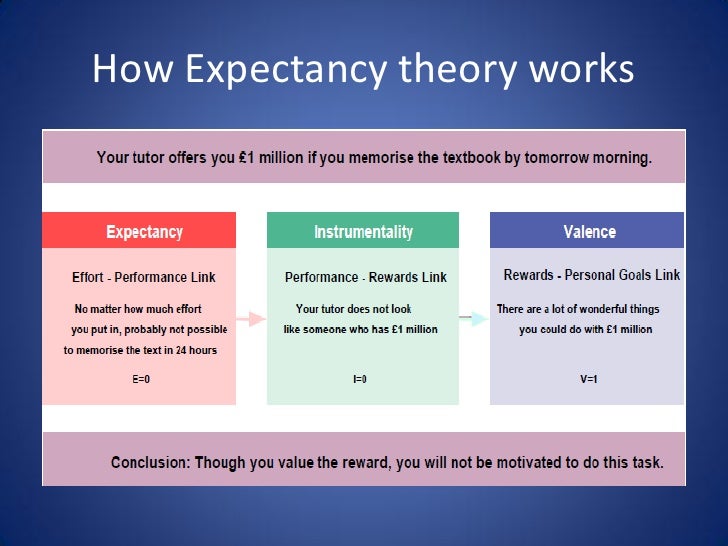Vroom 1964 Expectancy Theory Pdf To Jpg
Vroom explains his theory using three variables: valence, expectancy and instrumentality. Valence basically refers to the reward for good work, and how desirable the reward is to them. Expectancy represents each employee's own confidence in his or her capability when it comes to possessing the work skills needed to perform well enough to achieve the reward. The instrumentality variable refers to employees' need to believe that when management offers a reward for good work performance, they actually deliver the rewards consistently. The theory won't work in practice without active participation from managers. The theory assumes all components are already known.
Vroom's Model Of Expectancy Theory
In reality, leaders must make an effort to find out what their employees value as rewards (valence).They must also accurately assess employees' capabilities (expectancy) and make available all of the right resources to help employees be successful in their jobs. Managers must also keep their word; employees need to trust that if they put in the work and effort, they will actually get the promised reward (instrumentality). Another weakness of expectancy theory is when management offers certain motivations and rewards, but the employees don't value or believe in them.

This is the main leverage management has to guide their team's behavior, so if they don't choose rewards with enough perceived value, employees will lose motivation to perform. For example, managers believe that an extra $5 of wages should motivate an employee, but that employee might only find an increase rewarding and immediately valuable if it were at least $10. Because of management's lack of understanding, the employee isn't motivated. Cynthia Gaffney has spent over 20 years in finance with experience in valuation, corporate financial planning, mergers & acquisitions consulting and small business ownership. She has worked as a financial writer and editor for several online finance and small business publications since 2011, including AZCentral.com's Small Business section, The Balance.com, Chron.com's Small Business section, and LegalBeagle.com. A Southern California native, Cynthia received her Bachelor of Science degree in finance and business economics from USC.
Vroom’s Expectancy Theory is based on the assumption that an individual’s behavior results from the choices made by him with respect to the alternative course of action, which is related to the psychological events occurring simultaneously with the behavior. This means an individual selects a certain behavior over the other behaviors with an expectation of getting results, the one desired for.Thus, Vroom’s Expectancy Theory has its roots in the cognitive concept, i.e.
How an individual processes the different elements of motivation. This theory is built around the concept of valence, instrumentality, and Expectancy and, therefore, is often called as VIE theory.The algebraic representation of Vroom’s Expectancy theory is:Motivation (force) = ∑ Valence x ExpectancyValence: It refers to the value that an individual places on a particular outcome or a strength of an individual’s preference for the expected rewards of the outcome. To have a positive valence, one should prefer attaining the outcome to not attaining it. For example, if an employee gets motivated by promotions, then he might not value offers of increased incentives.
Vroom Expectancy Theory Example
The valence is zero if an individual prefers not attaining outcomes to attaining it. In the above example, an employee agrees with the increased incentives.Instrumentality: Another major input into the valence is the instrumentality of first level outcome in obtaining the second level outcome, i.e. A degree to which the first level leads to the second level outcome. For example, suppose an employee desires promotion and he feel that superior performance is a key factor to achieve the goal. Thus, his first level outcomes are superior, average and poor performance and the second level outcome is the promotion.Hence, the first level outcome of high performance acquires the positive valence so as to have the expected relationship with the second level outcome of the promotion. Thus, an employee will be motivated to perform efficiently with a desire to get promoted.Expectancy: Expectancy, another factor that determines the motivation, refers to the probability that a particular action will lead to the desired outcome. The expectancy is different from the instrumentality in the sense; it relates efforts to the first level outcome, whereas the instrumentality relates to first and second-level outcomes to each other.
Thus, expectancy is the probability that a particular action will lead to a particular first-level outcome.